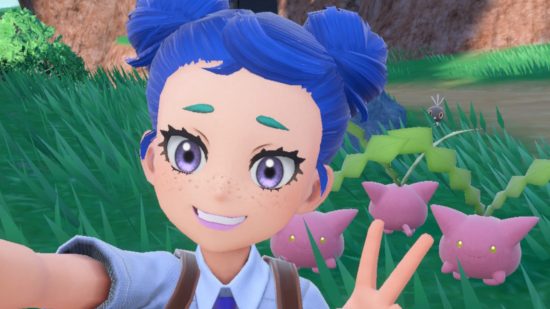Over the past decade or so, we’ve seen game accessibility come on leaps and bounds across the industry. Game designers are beginning to realise that by making their games accessible, and doing this from the very beginning of the design process, everyone has a better gameplay experience. Accessibility features in games can take many forms, from colourblind options to customisable subtitles to extensive button remapping. But Nintendo and its first-party games seem to be lagging behind.
Specifically, Pokémon, which is the biggest entertainment franchise in the world, is on a less-than-optimal trajectory when it comes to accessibility. Previous Pokémon games have been relatively accessible given the limitations of their hardware – most can be played one-handed, the story and progression are linear, and they don’t require aiming or button mashing. But as the Pokémon main series moves towards an open-world experience, some players have been left behind.
I’ll start with something positive that both Pokémon Legends: Arceus and Pokémon Scarlet & Violet got right with their open worlds, and that’s the quest system. As someone with ADHD, I find it incredibly difficult to keep track of multiple quests at a time and I need waypoints to stop me from getting sidetracked in an open world and completely forgetting my objective. Both Legends and Scarlet & Violet have quest waypoints and they make my experience in the vast, sprawling world playable. Sure, it’s not as intensive as Genshin Impact’s quest list and custom map waypoints, but at least they didn’t take the Elden Ring approach, which I like to call, “I dunno, figure it out.”
As a neurodivergent player, I’ve never really struggled with Pokémon games, and provision for my specific access needs seems to have only improved as the franchise grows and evolves, but I can’t say the same for many other disabled gamers. Players with hearing impairments, visual impairments, and motor disabilities are frequently left behind as Pokémon progresses into the future, and what’s worse is that this is sometimes a result of other members of the fanbase silencing disabled voices.
The particular case that comes to mind is about shiny hunting. The way that shiny Pokémon work has changed a few times over the years, including an increase in spawn rate to one in 4,000 Pokémon. The biggest change that came with the Switch generation of games is that as of Pokémon Let’s Go, shiny Pokémon are now visibly shiny in the overworld, meaning you don’t have to engage every Pokémon you see in battle to see if it’s shiny. Legends Arceus made spotting a shiny even more accessible with the addition of a shiny-specific side quest, and visual and audio cues when you spot a shiny.
This makes shiny hunting a lot more accessible for visually impaired players who could rely on the audio cue and colourblind players who could use the audio cue and the sparkle effect to distinguish a shiny without needing to see its colour palette. The audio cue plays whenever a shiny Pokémon spawns in, whereas the visual cue requires you to be looking at the Pokémon, so many disabled gamers like Laura Kate Dale advocated for these accessibility features to be built on in generation nine so that hard-of-hearing players were at less of a disadvantage.

Sadly, other members of the shiny hunting community thought that these accessibility features that benefit a wide range of disabled and able-bodied players make the hobby ‘too easy’, and it would seem The Pokémon Company heard their complaints above the praise and suggestions for improvement from disabled fans.
Scarlet & Violet have made shiny hunting less accessible than it was in Legends Arceus, instead of improving on what we already had. Yes, shiny Pokémon are still colour-swapped in the overworld, but there are no more audiovisual cues when a shiny spawns or even when you lock onto one. These trigger when you engage them in battle like in previous games, but this makes the shiny hunting process for visually impaired and colourblind players grindy and arduous compared to the experience of able-bodied players.
To make matters worse, some of the Paldean shiny forms of Pokémon are the most subtle palette swaps in the history of the franchise or are only visible on a tiny part of the Pokémon, such as Charcadet’s eyes. Given the issues with Pokémon Scarlet & Violet’s graphics, this can make shiny hunting ridiculously difficult. Luckily, the game’s new Let’s Go autobattling system provides a workaround as your buddy refuses to fight shinies, but this is still a much longer process to find a shiny than simply being able to spot one in a group.
A lot of what frustrates me about issues with game accessibility is that disabled gamers aren’t asking developers to make every single accessibility feature possible part of the standard game – we just want to have the option. People may not realise it, but existing features like text speed and skipping cutscenes are accessibility features. If I have the option to skip cutscenes so I don’t ruin my gaming experience by breaking out of hyperfocus, why can’t a colourblind player have the option to turn on a colourblind palette, or a sparkly visual cue for shinies?
The option menus in Pokémon games are notoriously limited, with just a few audio mixing sliders and the aforementioned text speed options. When you compare it to games like The Last of Us Part Two and Hades, you really begin to wonder why the biggest franchise in the world gives us so few options to improve our gameplay experience.
Not just Pokémon but the Switch as a whole is particularly bad for fine motor control accessibility. The switch to open-world areas in Pokémon Legends Arceus and a whole open-world map in Pokémon Scarlet & Violet means that it’s virtually impossible to play these games one-handed as you need to use both analogue sticks to control the camera. There’s some button remapping capability on the Switch, but it’s not viable to remap everything needed to play one of these Pokémon games to a single JoyCon.
As it’s one of my favourite franchises, I’m desperately hoping that Game Freak and The Pokémon Company listen to the feedback from disabled players and implement some changes either in the heavily rumoured Pokémon Scarlet & Violet DLC or wherever the games go next.
If you’re after some help on your Paldean journey, check out our guides on how to evolve Finizen, how to evolve Riolu, and how to evolve Pawmo. Or if your laptop needs a refresh, check out our favourite Pokémon wallpapers.














